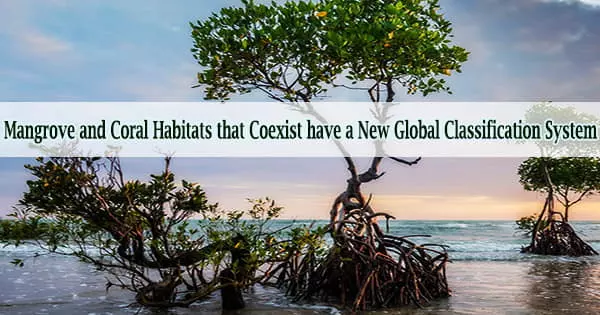Between 2016 and 2019, Heather Stewart might be spotted snorkeling at the Bocas del Toro archipelago off the Caribbean coast of Panama on any given day. She spent years going to these forests at the sea-land transition, attempting to figure out what prompted corals to grow there. In tropical coastal areas, corals and mangroves frequently coexist, yet their shared habitat seemed to be an evolutionary feature that required an explanation.
In 29 locations where mangroves and corals coexist in Bocas, the former doctoral fellow at the Smithsonian Tropical Research Institute (STRI) and current Mangrove Restoration Postdoctoral Associate at the University of the Virgin Islands discovered that the corals fared best in sizable, flooded mangrove forests with high levels of seawater flow.
Conversely, corals were unsuited in regions with significant levels of freshwater inflow or human-impact land development and pollution.
There are mangrove-coral relationships outside of the Caribbean and Bocas del Toro. Corals are found in mangroves in tropical oceans all over the world, including the Red Sea, Indian Ocean, and South Pacific, despite little research on them.
In light of this, Stewart and a team of researchers from STRI, the University of Miami, Santa Fe College, and the University of Florida set out to develop a classification system for coexisting mangrove-coral (CMC) environments globally. They examined academic research and determined the key traits and circumstances present in these ecosystems.
“We believe it is important to have a global classification system for coexisting mangrove-coral habitats because for nearly a century these systems have been known to exist, but were largely ignored by the scientific community,” said Stewart.
“Now with all the threats corals face from ocean warming and acidification to pollution and sedimentation, corals are becoming more susceptible to diseases. Thus, there is greater interest in potential refugia to aid in the future of coral survival.”
There are greater differences in the environmental conditions among coexisting mangrove-coral habitat types than between some CMC habitats and shallow reef habitats. It is by identifying the CMC type and collecting information on these environmental variables, that we can determine how mangroves may function as a life raft for some species of corals.
Heather Stewart
Four distinct habitat types where corals coexist with mangroves have been identified by their analysis, which were recently published in the journal PLOS One: lagoons, creeks, the edges of mangroves, and areas entirely in the shade of the mangrove canopy. There are roughly 130 different types of coral that live in these settings, which adds to their diversity.
“Going back to the historic literature in search of CMC descriptions helped us understand the holistic view that we needed to classify the systems,” said Rafael Araújo, co-author of the study and Senior Research Associate in the Department of Marine Biology end Ecology of the University of Miami’s Rosenstiel School of Marine & Atmospheric Science.
“We were inspired by early classification systems of mangrove forests and corals, and tried to adapt their simplicity in our own classification. We wanted the types to be specific enough to draw a distinction between them, but also simple enough that they could be applied in the field with ease.”
A connection to the open ocean or open channels within the mangrove assemblage, a low freshwater input, clear water, and conditions that allow the corals to remain submerged throughout the whole tidal cycle are among the characteristics that the four CMC types have in common.
Since coral reefs are the home to around one-third of all marine species, protecting them is essential for the health of the oceans. Equally crucial habitats are mangroves, which act as nidifiers for tens of thousands of species, uphold water quality, and shield coastal areas from erosion and storms.
Understanding these alternate habitats where they coexist may have long-term ramifications for their conservation and management because they are some of the ecosystems most vulnerable to climate change and human impact.
“CMC habitats are unique and offer possibilities for conservation of key species and ecosystems,” said Jennifer Wright, co-author of the study, who conducted her master’s research at STRI, and is Assistant Editor of the Bulletin of Marine Science. “Improving our understanding of where these habitats occur and how the corals and mangroves interact is essential to determine the role CMC habitats will serve for coral survival and protecting the health of our oceans.”
The authors went one step further and developed a model to forecast the global distribution of additional CMC habitats. Their modeling revealed that these communities might be widespread throughout the tropics, with the Pacific Ocean probably hosting the bulk of them.
Future research should focus on these areas to learn more about the dynamics of various CMC habitat types and the environmental factors influencing their formation.
“There are greater differences in the environmental conditions among coexisting mangrove-coral habitat types than between some CMC habitats and shallow reef habitats,” said Stewart. “It is by identifying the CMC type and collecting information on these environmental variables, that we can determine how mangroves may function as a life raft for some species of corals.”
“This paper is also a call to other scientists to seek and document as best they can co-existing mangrove-coral associations,” said Araújo. “As more information becomes available, we will better understand the environmental conditions that make these systems thrive. As such, we hope to see many more descriptions of CMC habitats in the literature, and how these new occurrences fit into our classification.”





